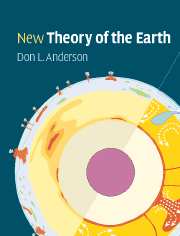Book contents
- Frontmatter
- Contents
- Preface and Philosophy
- Abbreviations and acronyms
- Part I Planetary perspective
- Part II Earth: the dynamic planet
- Part III Radial and lateral structure
- Part IV Sampling the Earth
- Part V Mineral physics
- Chapter 18 Elasticity and solid-state geophysics
- Chapter 19 Dissipation
- Chapter 20 Fabric of the mantle
- Chapter 21 Nonelastic and transport properties
- Chapter 22 Squeezing: phase changes and mantle mineralogy
- Part VI Origin and evolution of the layers and blobs
- Part VII Energetics
- References and notes
- Appendix
- Index
Chapter 21 - Nonelastic and transport properties
Published online by Cambridge University Press: 05 June 2012
- Frontmatter
- Contents
- Preface and Philosophy
- Abbreviations and acronyms
- Part I Planetary perspective
- Part II Earth: the dynamic planet
- Part III Radial and lateral structure
- Part IV Sampling the Earth
- Part V Mineral physics
- Chapter 18 Elasticity and solid-state geophysics
- Chapter 19 Dissipation
- Chapter 20 Fabric of the mantle
- Chapter 21 Nonelastic and transport properties
- Chapter 22 Squeezing: phase changes and mantle mineralogy
- Part VI Origin and evolution of the layers and blobs
- Part VII Energetics
- References and notes
- Appendix
- Index
Summary
Shall not every rock be removed out of his place?
Job 18:4Most of the Earth is solid, and much of it is at temperatures and pressures that are difficult to achieve in the laboratory. The Earth deforms anelastically at small stresses and, over geological time, this results in large deformations. Most laboratory measurements are made at high stresses, high strain rates and low total strain. Laboratory data must therefore be extrapolated in order to be compared with geophysical data, and this requires an understanding of solid-state physics. In this chapter I discuss processes that are related to rates or time. Some of these are more dependent on temperature than those treated in previous chapters. These properties give to geology the ‘arrow of time’ and an irreversible nature.
Thermal conductivity
There are three mechanisms contributing to thermal conductivity in the crust and mantle. The lattice part is produced by diffusion of thermal vibrations in a crystalline lattice and is also called the phonon contribution. The radiative part is due to the transfer of heat by infrared electromagnetic waves, if the mantle is sufficiently transparent. The exciton part, is due to the transport of energy by quasiparticles composed of electrons and positive holes; this becomes dominant in intrinsic semiconductors as the temperature is raised. Thus, thermal conduction in solids arises partly from electronic and partly from atomic motion and, at high temperature, from radiation passing through the solid.
- Type
- Chapter
- Information
- New Theory of the Earth , pp. 274 - 281Publisher: Cambridge University PressPrint publication year: 2007



